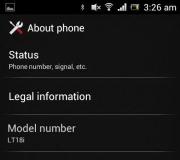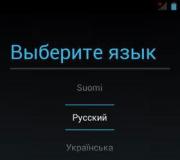Vault virus how to recover avast files. Vault virus how to recover files
Viruses can create annoying advertising and use your traffic for your needs. But it’s doubly unpleasant when hackers resort to blackmail, limiting access to your files and demanding money. If you have lost access to documents, and for normal operation need to pay, then you have become a victim dangerous virus Vault which is actively spreading across the network.
What is the Vault virus?
This virus refers to encryption programs. It downloads to your computer a simple program, which encrypts Word files, Excel, mp3 files, graphic images, assigning them the extension *.Vault.
After encryption, the user completely loses access to the data. To restore access, the program creates a special key. It remains in the hands of hackers. Blackmailers demand money for providing the key.

Distribution routes
The virus spreads in disguise through email, Skype or social media. It is an executable script with the .js extension. In some cases, attackers package the virus in an archive to make it more difficult to track.
After the user runs the script, the virus is downloaded from the hackers’ servers, and then settles in the TEMP folder and encrypts the files. Antiviruses do not block Vault, because... they see it as a safe cryptographer, - useful utility, which is used to protect data from hackers.
Removal
By the time you discover the virus, it has already done its dirty work. Therefore, hackers don’t particularly bother creating any kind of protection for their brainchild. The Trojan files are located in .
Under no circumstances should you delete everything. Before you remove the Vault virus from your computer, be sure to save following files:
- CONFIRMATION.KEY— displays the number of encrypted files. This is a kind of “estimate” for attackers. Thanks to it, they determine the amount of money they are willing to demand for the renewal of access.
- Vault.KEY- key to data. It contains an identifier that hackers use to find the access key to your specific files.
- Vault.txt— general information about the renewal procedure and the website of the hackers.
It's not a fact that you will need these files. But it’s better to store them just in case.
After you have cleared the folder, scan the system with the free program CureIT from DrWeb, and. Then you need to restart your computer and launch the task manager. If there are no suspicious processes among the processes, then everything went correctly, and the easiest part of the journey is left behind.
Decrypting files after infection
In their messages to victims, hackers write: “Hurry up, you don’t have much time,” or “Time is working against you.” Attackers need you to panic, to make a spontaneous decision, without thinking, to part with money for access to important files. You need to do exactly the opposite. You have encrypted files, and ways to regain access to them:
- Buy a key from ransomware.
- Try to find traces of the key on your computer.
- Restore backups files.
- Take advantage of solutions from antivirus laboratories.
Buying a key from hackers
Buying a key from hackers is like fulfilling the demands of terrorists. From a moral point of view, this is obviously the worst idea. The money you fund your own deception will later be spent on advanced types of fraud. But this option does exist, because there are confirmed cases of returning access after payment.
Search for a decryptor in the system
It is much better to try to recover the files yourself. There is an easy way to recover files after a Vault virus. Since the malware is based on a secure encryption program, the decryption key is initially created on the computer's hard drive. It is then sent to the hackers' server. And only then it is deleted. Therefore, first of all, look for the key. It may not have been removed yet. Key name is secret.gpg. If you can find it in the system, you are lucky.
Restoring saved copies
You can also restore copies of files. If you have system protection enabled, Windows applies a backup procedure to your files. Click on the file right click, open the “Properties” tab. In the window that opens, click “ Previous versions" We restore them and use them.

Solutions from antivirus laboratories
Both Kaspersky Lab and DrWeb admit that fighting encryption viruses hard. It is also difficult to identify them in the system. But antivirus laboratories have decryptors, which in some cases help in the situation. For Kaspersky it is RectorDecryptor. The utility itself searches for and corrects affected files.

If this option does not help, send the file for analysis to DrWeb, and they will select a decryptor for your specific case. Write a request describing the problem to support on the official website of the laboratory. After reviewing the problem, specialists will offer to send 3 files:
- CONFIRMATION.KEY;
- Vault.KEY;
- An example of an encrypted file.
As a result, you will receive either a utility customized for a specific case to unlock all files or an existing file.
Third Party Services
Due to the spread of the virus, the number of web services offering unlocking for money has increased. Such services should not be used under any circumstances. As Kaspersky Lab warns, if progressive think tanks are unable to solve the problem, there is no point in hoping for salvation from a dubious organization.
You should not use programs that such organizations offer to install. Vault often uses the open encryption method RSA-1024, and technically, it is simply impossible to unlock it by machine.
How to protect yourself from the virus in the future
Vault viruses are rarely detected by antivirus programs. Therefore, there are a number of rules, guided by which you can protect yourself from ransomware in the future:
- Check your files. Documents with the .js extension that come to you by email or on social networks are a priori dangerous. You should not open them, and if you want to take part in the fight against hackers, it is better to immediately send them for analysis to anti-virus laboratories.
- Copy the data. Store backups where the virus cannot damage them. Use removable media. Sync with cloud services, such as OneCloud, DropBox, GoogleDrive, or Ya.Disk.
- Trust a trusted source. Avoid programs whose sources you are not sure of. If the application has an official supplier available, it is better to use it rather than solutions from unknown organizations.
- Avoid pirated products. Fraudsters don't come alone. When you download a hacked game, or software, then you risk getting an embedded virus. A license is a waste. At the same time, there is safety.
The VAULT encryptor first appeared in Russia in February 2015, gaining a reputation one of the most dangerous and incurable viruses. In November, a second wave of infections began, which was more widespread. The third wave occurred in mid-January 2016. and surpasses the previous ones in the number of infected devices.
In this article we will cover:
what is the VAULT virus
what types of documents does the encoder encrypt?
how to protect your computer from ransomware attacks
how to remove VAULT from your computer
how to recover VAULT files
VAULT decryptor in computer services
What is the VAULT ransomware virus?
The VAULT virus is a type of encoder Trojan.
Penetrating the computer through user actions, the program encrypts certain type data from dozens of algorithms with a unique pattern.
The original data is not deleted, but replaced with damaged data, which makes the possibility of their recovery almost impossible.
The key that makes it possible to decrypt information is automatically deleted from the system after encryption is completed.
The goal of the attackers is to extort money in exchange for decrypting data. The probability of decrypting files even in this case does not exceed 50%.
An example of a computer being infected with the VAULT virus: a request for primary documentation from a counterparty, or a notification about the need to install an update package from ConsultantPlus, is sent to your work e-mail. A file with explanatory information is attached to the letter. Once the executable and auxiliary files are launched, the data encryption process begins.

What files does VAULT encrypt?
Attackers are interested in commercial information, as well as photo, audio and video materials. Thus, files with the following extensions are at risk: .rar, .zip, .jpg, .psd, .doc, .xls, .ppt, .pdf, .mp3, .ogg, .avi, .mpeg, .html, . txt, 1C databases, etc.
When a computer is infected, a text document with contacts of scammers. The cost of data decryption varies from $10 to $50,000. The cost is assessed by scammers after the user contacts them. The amount of the ransom depends on the volume of encrypted information. However, there is no guarantee that the data will be recovered at least partially.
How to protect your computer from the VAULT encryptor?

In most cases, infection occurs when there is no antivirus on the computer, or when using a free version of the software. The least reliable, in our opinion, is Avast antivirus.
However, holders of licensed antivirus package programs, including corporate versions.
IT security specialists from ESET and Dr.Web have developed a number of universal recommendations that help protect your computer or laptop from the VAULT virus and similar encryption Trojans:
install critical operating system updates in a timely manner
choose antivirus programs with a built-in firewall
prohibit reception and transmission executable files(.exe) on the mail server
disable running macros in Microsoft Office, or similar software
exercise regularly backup data
duplicate important information to external media
How to remove VAULT from your computer?
At the moment, infection with the VAULT virus and data encryption is one-time and does not lead to infection system files. Thus, to remove a virus from the system, it is enough to scan with the CureIt utility from Dr.Web. However, you should remember that attempts to cure or delete infected files, as well as reinstall Windows, will reduce the ability to restore encrypted data to zero.
That is, there is nothing difficult in removing a virus if you are ready to part with encrypted information forever, or you have backup copies on external media.
How to recover VAULT files?
As soon as you discovered an infection We saw the changed file icons and new type extensions, for example, .doc.vault, turn off your computer or laptop immediately. The longer he works, the larger number you will lose files.
Let’s repeat: scanning the disk with an antivirus, disinfecting files, reinstalling the system, and others standard means will only reduce the likelihood of data decryption.
None of the developers antivirus software has so far been unable to create a utility to decrypt information exposed to VAULT.
The system restore points are destroyed by the virus. There is a chance to restore Windows from shadow copies using the Shadow Editor utility when working with Windows Vista/7 /8 /10. But in most cases, shadow copies also disappear.
If you have a licensed NOD32 or Dr.Web product, you can contact them technical support with a request to decrypt the data.
In addition, experts recommend contacting the police with a statement, since the actions of the attackers contain signs of crimes under Art. Art. 159.6, 163, 165, 272, 273 of the Criminal Code of the Russian Federation.
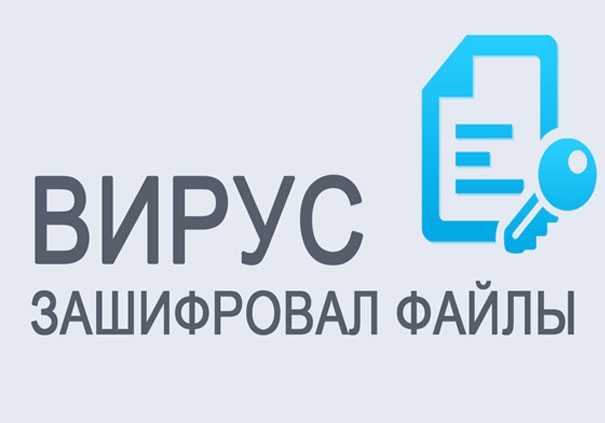
But there are still cases when malware bypasses all levels of protection. And there are viruses that are easy to overcome, and there are those that will take a long time to deal with. One of these is the Vault virus. Today we will talk about how to get rid of this harmful virus.
Vault is a ransomware virus. This virus infects the computer and then begins to encrypt the files on it. Almost all files are affected by this virus and after that .vault is added to their extension. This virus infects almost all types of documents that you have on your computer. And you won’t be able to work with them, because when you open many of them you will see something like this.

Most often, the Vault virus gets onto your computer through email. Let's say you received, it would seem at first glance, important letter and you opened it. And in this letter there is some kind of attachment. By opening it, you launch a virus onto your computer.
As soon as you discover the Vault virus on your computer, immediately stop working on the Internet and try not to open folders. You can remove the virus using any high-quality antivirus or other similar program, For example, . On at this moment There should be no difficulties, since Vault is extremely easy to remove.
But the files remain infected. In this case, you need to go to Temp folder. In it you will see the following files: 3c21b8d9.cmd, fabac41c.js, VAULT.txt, Sdc0.bat, VAULT.KEY, CONFIRMATION.KEY. Delete everything except the last two and after that the computer registry using .
Two latest file are not deleted, since the first file is the encryption key, and the second is a file that contains information about the number of encrypted files. In a desperate situation, these files are transferred to the attackers and they provide you (for a fee) with a key to decrypt the files.
Is it possible to recover files encrypted by the Vault virus yourself? In fact, there are very few ways to do this. The very first thing that can help with this is to restore files to their previous versions. But not all computers have this feature enabled.
If the files were stored on network or cloud storage, then it's worth checking the baskets. In most cases the files will be there.
The Vault virus is very insidious malicious tool, after which there is little chance of recovering infected files.
Data encryption- This new way with which scammers try to get cash With deceived people. On the network, already For a very long time there have been viruses that encrypt all documents, pictures and other files, installing various incomprehensible files for them, after which a message appears that you need to send 5,000 rubles for decryption, and only then you can get your files back.
No matter how sad it is, many people fall for these deceitful scams and simply out of desperation, in order to save their photos or Word documents, pay these scammers money, which motivates them to continue their lawless activities.
So, now I’ll tell you, what is a Vault virus and how can you recover files after infection?. This particular virus lately started surfing the net. It was distributed by mail (E-Mail), in the form of a letter from the accounting department, like: “Very important documents for November, be sure to look.” And as soon as the user opened the archive, the process of encrypting files into the Vault format started. After this, as a rule, there is no longer one required file no longer opened correctly.
Apparently it was some kind of regular mass mailing, because this problem I discovered from two of my friends, as it turned out later, that at work, eleven more computers were infected with the Vault virus.
How I tried to overcome the Vault virus and restore damaged files
So, as I think, you already understood that my friends turned to me so that I could help them return these files, since there were photographs, work documents, and much more on the computer useful information. When I looked at both computers, the situation was absolutely the same, the same letter from the accounting department, and all the documents encrypted in vault format.

Like everyone else, first of course I ran , the scan was completed and found several files, which were eventually successfully deleted. Thus, I may have removed the Vault virus, and most likely when creating new files they will not be changed, but the encrypted files in Vault remain in the same format, and this is not what we need.
On the Internet it was recommended to find the keys in certain folders. But as soon as I got there, nothing was found there, and the negative result concerned both computers. Then, they also recommended restoring data that was damaged by the Vault virus using shadow files, but unfortunately this didn’t work out either.
Next, I tried to use various decryptors, but they could not cope with their task and did not decrypt files with the Vault extension. The reason for this was most likely that these decryptors were created even before such an extension appeared, so most likely they could not recognize new format virus.
Then, I made the following decision, I wrote to the support service Dr. Web asking for help removing the Vault virus and restoring files. After talking for a while, I finally received an answer to the question of how to decrypt files in Vault, in the form of another decryptor.
Having launched it, my joy knew no bounds; this utility returned all the files to their place on both computers. What am I, you should have seen the faces of my friends when I returned their computers to them.
Vault virus treatment and file recovery
First, download the decoder here and save it wherever your heart desires.
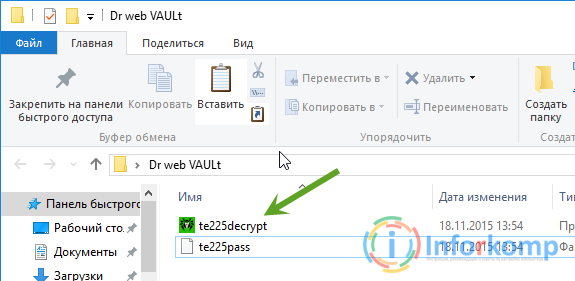
Now, having launched it, click on the button “ Сontinue».
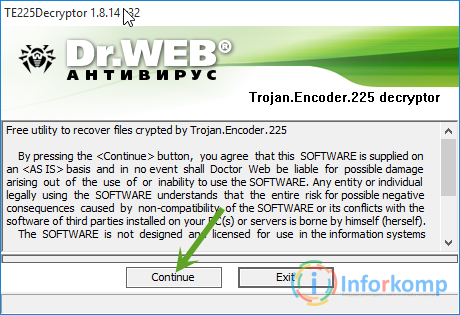 After this, a search window will appear in which you need to substitute at least one encrypted file in vault format.
After this, a search window will appear in which you need to substitute at least one encrypted file in vault format.

It will take some time to search for such data and decrypt it back to normal.
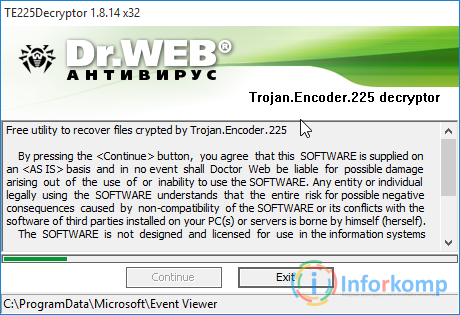
Having finished your work, you will be able to see the same files next to the encrypted ones, only in normal working condition.
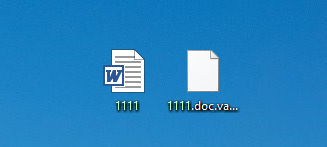 As if that was all, this is how a solution was found to the question of how to treat the Vault virus and then restore encrypted files. I note that credit must be given to Dr. Web and thank them so much for this.
As if that was all, this is how a solution was found to the question of how to treat the Vault virus and then restore encrypted files. I note that credit must be given to Dr. Web and thank them so much for this.
Today we will talk to you on the topic: “We caught the Vault virus: what to do?” This topic is very important, especially in modern world, where a variety of computer infections are literally at every turn. What is it? Where can you find this crap? How does it work? All this will be discussed now.
"With whom do I have the honor?"
The first thing we should start with is that you and I find out what kind of rubbish this is: the “Vault” virus. We’ll talk about what to do with it and how to deal with it a little later.
As already mentioned, we will have to deal with the so-called data encryptor. It penetrates the operating system and begins to change (encrypt) the extensions of all your data. It's good if it's only personal information. And if a computer infection has reached system files, then things are very bad.
If you have caught the “Vault” virus and don’t know what to do, then the first thing you need to do is understand where this “beast” came from on your computer. The thing is that this thing looks different. For some it is a program for archiving data, while for others it seems special extension for the browser. The result is the same - your Internet access is “hijacked” and your files are slowly encrypted. Here is such a cunning "Vault" virus. What to do with it? We'll figure it out now.
Examination
Well, the first stage of the fight against absolutely any infection on your computer is nothing more than checking your system for the presence malicious files and spies. For this you will need If you are thinking about the question: “Vault” virus: how to treat?”, then it is best to use Dr.Web or Nod32. If they are not to your taste, then you can also use Avast.
Update the virus database and then run a deep scan. This process may take you quite a long time. However, you will have to wait. Once completed, take a look at the results. Among them, the “Vault” encryption virus will definitely appear. What to do with the received data? It is enough to simply try to cure all malicious software. Anything that cannot be treated should be removed. This is done using special button in the antivirus. Now that you have scanned your computer, you can proceed to the next step. 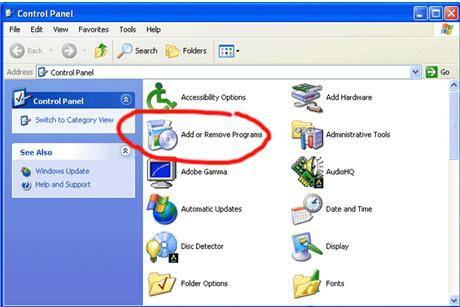
Getting rid of programs
So, it's time to start cleaning up your computer. If you are thinking about the question: “Vault” virus: how to treat it?”, then try to rid the operating system of a variety of strange content and programs that you have not used for a long time, as soon as possible.
The thing is that both browser hijackers and encryptors love to write all sorts of useless content into the computer, which helps encrypt data. Getting rid of such programs will simplify the task of treating the operating system.
In order to answer the question: once and for all?”, go to and from there go to “Installation and Wait until the list is generated installed content, and then remove all programs that are unfamiliar to you. At the same time, clean the system of those applications that are already for a long time"gathering dust" on the sidelines. Ready? Then you can close the window that appears and proceed to the following measures, which will definitely help you cope with the task. 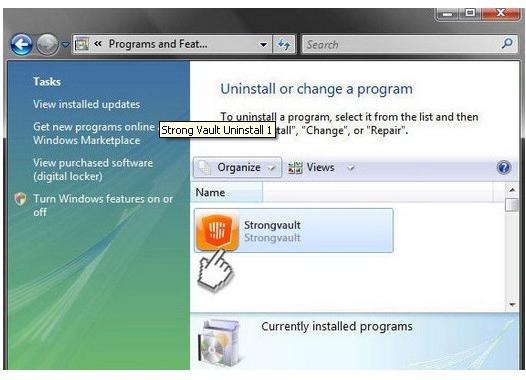
Registry
When users are faced with the question: “Vault” virus: what to do if infected?”, many forget about such an important thing as the computer’s registry. It is in it that the computer infection is “registered,” which can then be quite difficult to get rid of.
So, let's think about how exactly we can clean the registry. To do this you will have to do special team(she helps us get into the service we need). Press Win + R and then run the command "regedit". After you click on "Enter", your computer's registry will open. You can continue to think about the topic: “Vault virus: how to remove?”
Well, after we get into the service we need, we will have to think about where we need to “climb” in order to cope with the task. On the left you will see many folders with long names. We skillfully bypass them and head to the “edit”. There we find “search” and type “Vault” in the line. Run the scan and wait until you are shown the scan results.
Anything your computer detects will have to be deleted. Don't be afraid - after this you won't "fly" operating system and the files will not be damaged. So just right-click on the lines and then select the “delete” command. Ready? Then let's move on. There are only a few left simple steps, which will help solve the problem with our current ransomware. 
Program help
Probably, when fighting any malware it is impossible to do without the so-called third party programs, which help to find and “neutralize” viruses. For example, Cclener is a great choice. This is an application that cleans the computer's registry (most effective after manual cleaning this service) and helps free up space on system disk C.
You just need to download CCleaner and install it. After launching, on the left side of the window, simply set the desired scanning settings (which sections to search), and then click on the “Scan” button. Just a few seconds - and the results are already in your hands. All you have to do is click on “Clear” and look at the result.
In addition, if you are thinking about the topic: “Vault virus: what to do?”, you can also use the so-called SpyHunter. This is content that helps detect malware and spyware, as well as removing this kind of infection. After installation and scanning, you can restart your computer. Eventually the virus will no longer bother you.
What to do with the files?
But now you should have a question: “What to do with encrypted personal data?” In fact, you can choose one of several available methods. 
The first one is suitable for particularly cautious users. Such people, as a rule, write all their files to third party media. They can be asked to delete the damaged content and then replace it with “normal” data.
The second option is to use special services from antivirus programs. Encrypted data is sent to them, after which you will receive a decryption in response. Dr.Web is quite successful in this difficult matter. That's it. Now you know what to do if you get the Vault virus.
